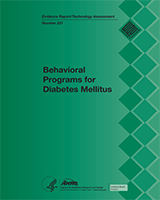From: Results

Behavioral Programs for Diabetes Mellitus.
Evidence Reports/Technology Assessments, No. 221.
Pillay J, Chordiya P, Dhakal S, et al.
Rockville (MD): Agency for Healthcare Research and Quality (US); 2015 Sep.
NCBI Bookshelf. A service of the National Library of Medicine, National Institutes of Health.